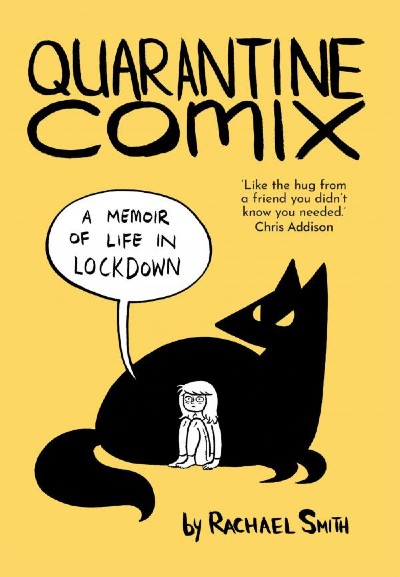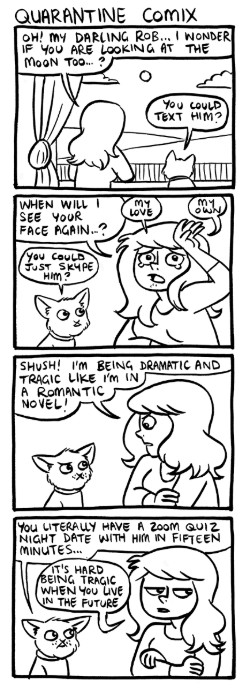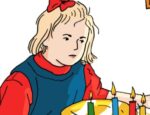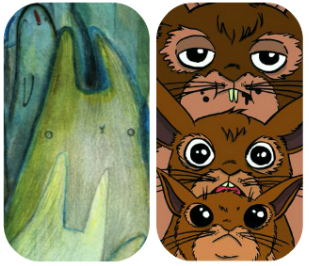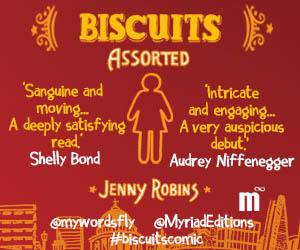For the best part of a decade Rachael Smith’s comics journey has weaved in and out of our coverage at Broken Frontier with a remarkable regularity. From her early self-published comics like I Am Fire to her first graphic novels like award-nominated The Rabbit from Avery Hill, through to her vitally important autobio work dealing with depression and anxiety in Wired Up Wrong and Stand in Your Power, Smith’s output has been as varied and eclectic as it has been prolific. That this is the fifth time I have interviewed her for BF since 2015 is a testament to her vital importance in the UK indie scene.
Over the last year Smith’s series of online Quarantine Comix on social media connected her to her audience with an intimacy that was both welcoming and empathetic. As the pandemic suddenly changed our lives forever, her daily reflections on our newfound situation – sometimes funny, sometimes poignant, but always relatable – became a regular reminder that we were not alone in our struggles to adapt to this harsh new world. With Quarantine Comix having been collected and published by Icon Books this month, I caught up with Rachael to chat about the origins of the strip, its resonance with its readers, and adapting the material for a new print format…
ANDY OLIVER: What was the impetus for Quarantine Comix? Were you consciously thinking about creating a social record of the time? Or was it as much an exercise in therapeutic diary comics?
RACHAEL SMITH: It was March 21st, the day before my birthday. I’d been feeling pretty useless about the virus and the impending lockdown, and was also really sad as my partner, Rob, had decided (quite rightly!) that it wasn’t safe enough for him to travel to spend my birthday with me. My friend Heather came over to cheer me up and suggested I start doing diary comics about the situation. She reminded me that, if I’m good at doing anything, it’s making people feel less alone through comics. Back then we thought it was only going to be two weeks before this virus was eradicated, so that seemed pretty doable! I started making daily comics about how I was feeling and about the changing world around me. Obviously, it was a lot longer than two weeks but I carried on regardless because by then, ‘Quarantine Comix’, as I called them, had become really cathartic for me. I don’t know whether I thought I was making a social record…all I knew was that I was making myself feel better, and others too.
AO: Like a lot of your autobio work there are elements of something approaching magic realism in Quarantine Comix. Can you tell us a little bit about the cast of characters who inhabit its pages, both real and representational?
SMITH: The main real characters are me, my partner Rob, my housemate Iain, and my best friend Heather. They recur quite a lot in the comics as, especially in the first lockdown, we were very much living in each other’s pockets and wanting to keep to small groups. I was in a bubble with Iain, but I went on lots of socially-distanced walks with Heather. The imaginary characters are Barky, a black dog who represents my depression, and Friendly, a white dog who represents my optimism. The two dogs act as a kind of shorthand for how I’m feeling – if Barky is very big and Friendly very small, then I’m not doing too good mentally – and vice versa. The dogs talk to me a lot but also bicker between themselves. Later in the comics they appear to have reached a truce of sorts and are quite happy in each others company. I suppose Rufus sits somewhere between real and imagined, as he is a very real cat, but doesn’t really speak English. Which is a shame.
AO: For many of us Quarantine Comix was such an important strip in 2020 because it was a reminder that we were not alone in our concerns and experiences. Which strips have most resonated with readers? And what has been some of the most rewarding feedback you have had?
SMITH: The ones with Rufus in always got a lot of love – because cats are awesome I guess! Usually the more contemplative ones seemed to resonate more with people. The ones where I bear my inner thoughts and you’re like ‘Oh, I didn’t realise other people were thinking that too!’. I’ve had amazing feedback throughout the project, and even more so now that the book is out. I hear again and again that Quarantine Comix helped people get through this awful year, and that is just amazing to hear, and very humbling that my scribbles could actually have an impact on folk like that.
AO: What has the balance between the cathartic and the emotionally draining been like while working on Quarantine Comix? Were there points where you felt like stepping back from the project?
SMITH: There were some days I didn’t manage to make a comic as I felt so drained – but there were also days were I frantically needed to get my feelings out and so made four or five in one day. I never felt like stepping back from it though, and even now I’m still writing them – I just don’t have the time to draw them these days as I’m working on other stuff, but writing them still helps. Whether it’ll even feel like the right time to go through and draw them I don’t know! I would say the balance between cathartic and emotionally draining was 50/50, but last year it was sometimes good to be emotionally drained. There were too many emotions in my brain anyway!
AO: Autobio work has its own very specific considerations. Did you ever have any reservations about putting up such personal and sometimes quite raw accounts of life in lockdown?
SMITH: I don’t have rules like ‘I will never talk about this’ or ‘I’ll never draw about that part of me’, but there have been comics I’ve started and not finished because it was just giving too much of me away. I’m pretty giving when it comes to autobio stuff, and I’ve always worn my heart on my sleeve, but there are boundaries, I just don’t know where they are until I hit them. I guess I’m still working them out in that sense. I’m also always aware of putting other, real folk in the comics, if they come across badly then I won’t draw it, or I’ll try to frame it another way. Luckily the folk I choose to surround myself with are wonderful.
AO: What is it about the newspaper strip-style that appeals to you for your autobio comics? Why does that format work so eloquently in communicating and sharing experience with an audience?
SMITH: It’s often much more of a challenge for me to communicate something in a short comic rather than a long one. In my long-form, graphic novel work I give my characters a lot of room to breathe, lots of splash pages and big panels. I saw this project as a good opportunity for me to challenge myself with that. Concise statements. I was never allowed to take up more than an A4 piece of paper, meaning that if I wanted more than four panels, I was punished with having to make them really thin. It was fun though, I do like rules like that as I think it forces you to be more creative. I think if you can’t fit how you’re feeling into four/five panels you’re maybe not 100% sure how you’re feeling in the first place. But that’s OK too!
AO: How did the book come to Icon?
SMITH: My agent, James, and I put together a pitch for the book and James shopped it around to publishers. Icon seemed really excited about it from the get go which was so wonderful. All the folk there have been amazing and are all genuinely passionate about what they do.
AO: What were some of the considerations for publishing Quarantine Comix in print? Was there anything you had to think about adapting for a new format?
SMITH: The only thing really was how the colour, full-page illustrations would fit in. We did think about leaving them out, but I feel like the book would have lost a lot if that had happened. The black and white comics are often quite dense and frantic, and the full pages give a respite from that – which is kind of indicative of how lockdown felt for me. In the house I’d have 500 thoughts all jostling for attention in my head, but then I’d go for a walk , or even just into the garden for a bit – and a lot of the full page illustrations are set outside – and it became quiet again. I like the idea that the difference between those two styles echoes the fact that lockdown was both loud and quiet.
AO: And finally as one of the most prolific cartoonists in UK comics what other projects are you currently working on? Is there anything else in the pipeline that you can tell us about?
SMITH: I’m almost done illustrating a comic called The Queen’s Favorite Witch, written by Benjamin Dickson and published by Papercutz. I’ve loved working on that because Ben is such a talented writer and his characters are so real they almost want to walk off the page and start talking to me. I hope I’m doing it justice. Other than that, my book Stand in Your Power has been selected as part of the Comics Mifa Programme at Annecy Animation Festival, which means I’ll be pitching it as an animated series – that would be so exciting if that happens! I also just finished a series of comics workshops at a primary school in Manchester which was really rewarding and organised by LICAF – Oh! And hopefully in October I’ll be doing a three weeks comics residency in a library in Prague, which has been arranged by the Lakes International Comics Arts Festival. There’s also some stuff I’m not allowed to tell you about yet…so, busy busy busy!
For more on Rachael Smith’s work visit her site here and follow her on Twitter here. and Instagram here.
Quarantine Comix is available in a bookplate edition from Gosh! Comics online here while stocks last
Interview by Andy Oliver





